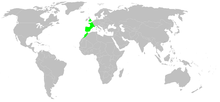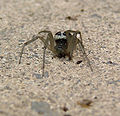Noble ball spider
| Noble ball spider | ||||||||||||
|---|---|---|---|---|---|---|---|---|---|---|---|---|

Noble ball spider ( Steatoda nobilis ), female |
||||||||||||
| Systematics | ||||||||||||
|
||||||||||||
| Scientific name | ||||||||||||
| Steatoda nobilis | ||||||||||||
| ( Thorell , 1875) |
The noble ball spider or noble fat spider ( Steatoda nobilis ), like other species similar to the real widows ( Latrodectus ) sometimes called the false widow , is a species of spider from the family of the crested web spiders . It was originally native to Madeira and the Canaries and was introduced in parts of Europe , Asia , North Africa ( Algeria ) and America . Due to its global distribution, the similarity to the real widows and the mostly much more harmless than often feared effect of its bite in the media, the species is getting more and more attention.
features
The female of the noble ball spider reaches a body length of 9.5 to 14 and the male one of 7.8 to 10.6 millimeters. The prosoma (front body) of both sexes is dark red-brown and provided with a dark and radial pattern. The legs have a lighter yellow-brown color, with the tibia on the distal side being darker than the rest of the legs. Both sexes differ significantly in terms of the color of their opisthosoma (abdomen). In the female, this is provided with purple and brown colors and several whitish stripes. The male opisthosoma has a beige to white basic color, a dark purple and leaf-like pattern and four larger and reddish spots. The epigyne of the female has a groove with a septum (septum).
Similar species

Like some other species of the genus, which are also called "false widow", the noble ball spider resembles the species of the much more prominent and feared real widows ( Latrodectus ) belonging to the same family . An essential distinguishing feature are the chelicerae , which are toothed in the fat spiders , a property that the true widows lack. Occasionally the noble ball spider is confused with the sector spider ( Zygiella x-notata ) belonging to the family of the real orb web spider and the dark spider of the genus Amaurobius .
Occurrences and introductions
The Noble orb spider was originally on the Macaronesian islands of Madeira and the Canary Islands spread, it was however in western and parts of central Europe , in Algeria , in Turkey , in Iran , in the United States , in Chile , and Ecuador and Colombia introduced and has established itself there. In Europe, the species was first sighted in Great Britain , Ireland , Portugal and Italy . In Germany, the noble ball spider was first detected in 2017 in two garden centers in Cologne. In the United States, their occurrence in the US state of California has been passed down, where the species first spread from Ventura County to Orange County , Alameda County , Monterey County and Santa Clara County .
The noble ball spider can be found on fences, stone walls, tree trunks, in hedges and on buildings, in the northern latitudes of the areas in which it was introduced, however, it is tied as a synanthropic representative to human settlements, especially in buildings.
Possible reasons for import
The spread of the noble ball spider into the areas previously uninhabited by it probably took place via various transport routes. The import of the spider to the British Isles is currently justified by the unwanted entrainment by tourists who previously visited the Canary Islands. The occurrence in the garden centers in Cologne is probably due to imports of plants from the Canary Islands or from areas that were already inhabited by the noble ball spider. The spread in South America probably happened via the Panamericana .
Threat and protection
The populations of the noble ball spider are not at least endangered by the global spread of the species. The IUCN classifies the species in category 4 ("not endangered") and is therefore not protected.
Way of life
In their habitat, the noble ball spider, like the other species in the family, builds a spider web for the purpose of catching prey. However, this differs significantly from those of other crested web spiders, as this is more like a funnel net in terms of its structure and functionality than the typical hooded net and thus more like the trap nets of funnel spiders and species from the Hexathelidae family . The noble ball spider differs from the webs of these spiders in that it is made of much stronger spider silk. The spider needs several days to build the web and the funnel follows at the end, whereby the web initially resembles that of other hooded web spiders.
Phenology and reproduction
While females of the noble ball spider can be found all year round, males are absent from March to May. The reproductive behavior of the noble ball spider is comparatively complex and diverse. It is therefore divided into several areas.
Courtship and mating
During the mating, which has so far been seen in midsummer (August), the male approaches the shelter of the female very quickly, which then turns to the male. Then the male begins a courtship in which the second pair of legs is moved up and down synchronously. These movements gradually become faster and in the end the entire body of the male is in motion. Then the male approaches the female or vice versa and the male touches with his front legs and touches the spermathec of his partner. Then the male leads his first globe into the female's egipyne and leaves it there for a while before the bulbs are changed, in the meantime separations and new courtship dances follow. It is not uncommon for the male to remain in the female's network after mating and both live as a pair in the female's network. The male also participates in catching prey. This coexistence not infrequently ends with the death of the male by the female, which sometimes happens immediately after mating, but occasionally can only occur a few months after mating.
Cocoon and hatch
Some time after mating, the female begins to produce an egg cocoon , which is made upside down at the tube entrance of the net. To do this, the female attaches her spinnerets there, then the spider slowly rotates several times around its own axis and pulls the spinnerets, which are then spread apart, back every two to three seconds. The spider forms the first surface of the cocoon below, which is given a fluffy structure due to the carding movement of the spider. Then she works on the edges and releases a yellow secretion into the construct to make the eggs stick, the eggs are then deposited. The cocoon is now closed from above. The young hatch about seven weeks after the cocoon is made. After leaving the cocoon, they need a total of four to five moults before they reach sexual maturity. The development to sexual maturity takes eight to fifteen months, irrespective of the weather and temperature.
Noble ball spider and human
The noble ball spider is feared in many places not least because of its similarity to the real widows and is held responsible for bites with dangerous complications. In fact, these can occur, but form the minority.
Toxicity and bite accidents
In principle, the noble ball spider is able to penetrate the skin of humans with its chelicerae , but like most spiders it is not aggressive and only bites in extreme need. The most common bite accidents result from males looking for a female and not infrequently getting into houses. As a rule, pain occurs at the site of the bite wound, which is roughly the same as the pain of a wasp spoke and usually subsides after 12, rarely only after 24 hours. Other common symptoms are swelling, erythema (inflammatory reddening) and itching around the bite site.
The false widow is held responsible for bites with necrosis and the resulting severe pain as a consequence. In most cases, this is probably due to an incorrect identification of the particular spider whose bite triggered these symptoms. These complications, which rarely occur when the noble ball spider bites, are probably the result of a bacterial infection caused by the bite.
Systematics
The noble ball spider experienced increasing changes in different genres including renaming. Called Lithyphantes nobilis by the first describer Tord Tamerlan Teodor Thorell in 1875 , it was first introduced in 1993 by Rowley G. Snazell and D. Jones as Steatoda nobilis , which has not changed since then.
gallery
Female with a captured dragonfly
Excerpt from the book "Proceedings of the Zoological Society of London" (1907) by Octavius Pickard-Cambridge , graphics 25 to 28 show motifs of the noble ball spider (here still listed as Teutana nobilis ).
Individual evidence
- ↑ a b c d e Steatoda nobilis (Thorell, 1875) from araneae Spiders of Europe, by Wolfgang Nentwig, Theo Blick, Robert Bosmans, Daniel Gloor, Ambros Hänggi & Christian Kropf , accessed on February 8, 2020.
- ↑ a b c d Steatoda nobilis (Thorell, 1875) on the BugGuide.Net website , accessed on February 8, 2020.
- ↑ a b c d Bite effect of the noble ball pider on the website of the Natural History Museum , accessed on February 11, 2020.
- ↑ a b Steatoda nobilis (Thorell, 1875) in the WSC World Spider Catalog , accessed February 8, 2020.
- ↑ a b c d T. Bauer, S. Feldmeier, H. Krehenwinkel, C. Wieczorrek, N. Reiser, R. Breitlin: Steatoda nobilis, a false widow on the rise: a synthesis of past and current distribution trends , NeoBiota 42 , 2019, pp. 19–43, accessed on February 11, 2020.
- ^ Steatoda nobilis (Thorell, 1875) on the NBN Atlas website , accessed February 11, 2020.
- ↑ a b Steatoda nobilis (Thorell, 1875) on the British Arachnological Society (BAS) website , accessed February 11, 2020.
literature
- T. Bauer, S. Feldmeier, H. Krehenwinkel, C. Wieczorrek, N. Reiser, R. Breitlin: Steatoda nobilis, a false widow on the rise: a synthesis of past and current distribution trends , NeoBiota 42, 2019, p. 19–43, accessed February 11, 2020.
Web links
- Steatoda nobilis in the World Spider Catalog
- Steatoda nobilis (Thorell, 1875) on the Global Biodiversity Information Facility website.
- Steatoda nobilis (Thorell, 1875) at araneae Spiders of Europe , by Wolfgang Nentwig, Theo Blick, Robert Bosmans, Daniel Gloor, Ambros Hänggi & Christian Kropf.
- Steatoda nobilis (Thorell, 1875) on the BugGuide.Net website.
- Bite effect of the noble ball pider on the website of the Natural History Museum.
- Steatoda nobilis (Thorell, 1875) on the website of the NBN Atlas.
- Steatoda nobilis (Thorell, 1875) on the British Arachnological Society (BAS) website.















